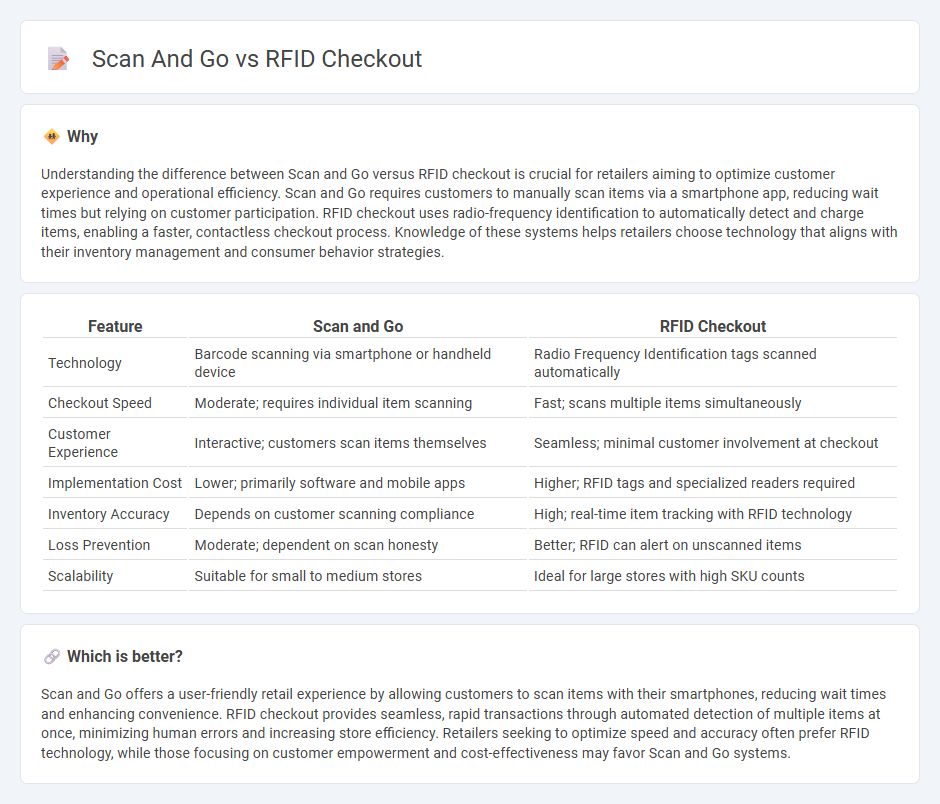
Scan and Go technology allows customers to use their smartphones to scan items and pay directly, reducing checkout time and enhancing convenience. RFID checkout employs radio frequency identification tags to automatically detect products at the counter, streamlining the payment process without the need for manual scanning. Explore more about how these innovative retail solutions are transforming the shopping experience.
Why it is important
Understanding the difference between Scan and Go versus RFID checkout is crucial for retailers aiming to optimize customer experience and operational efficiency. Scan and Go requires customers to manually scan items via a smartphone app, reducing wait times but relying on customer participation. RFID checkout uses radio-frequency identification to automatically detect and charge items, enabling a faster, contactless checkout process. Knowledge of these systems helps retailers choose technology that aligns with their inventory management and consumer behavior strategies.
Comparison Table
| Feature | Scan and Go | RFID Checkout |
|---|---|---|
| Technology | Barcode scanning via smartphone or handheld device | Radio Frequency Identification tags scanned automatically |
| Checkout Speed | Moderate; requires individual item scanning | Fast; scans multiple items simultaneously |
| Customer Experience | Interactive; customers scan items themselves | Seamless; minimal customer involvement at checkout |
| Implementation Cost | Lower; primarily software and mobile apps | Higher; RFID tags and specialized readers required |
| Inventory Accuracy | Depends on customer scanning compliance | High; real-time item tracking with RFID technology |
| Loss Prevention | Moderate; dependent on scan honesty | Better; RFID can alert on unscanned items |
| Scalability | Suitable for small to medium stores | Ideal for large stores with high SKU counts |
Which is better?
Scan and Go offers a user-friendly retail experience by allowing customers to scan items with their smartphones, reducing wait times and enhancing convenience. RFID checkout provides seamless, rapid transactions through automated detection of multiple items at once, minimizing human errors and increasing store efficiency. Retailers seeking to optimize speed and accuracy often prefer RFID technology, while those focusing on customer empowerment and cost-effectiveness may favor Scan and Go systems.
Connection
Scan and go technology integrates with RFID checkout systems by enabling seamless, contactless transactions where customers scan items with RFID tags directly via handheld devices or smart carts. RFID checkout automates item detection and billing, reducing checkout time and minimizing human errors, enhancing retail efficiency. Together, these technologies streamline the shopping process, improve inventory tracking, and optimize customer experience in modern retail environments.
Key Terms
Automation
RFID checkout uses radio frequency identification to automatically detect and process multiple items simultaneously, significantly speeding up the payment process compared to traditional scan and go methods that require manual barcode scanning. This technology reduces human error and enhances inventory accuracy by instantly updating stock levels as items leave the store. Discover how RFID checkout systems can revolutionize retail automation for improved customer experience and operational efficiency.
Inventory Accuracy
RFID checkout systems utilize radio frequency identification tags to automatically track inventory in real-time, significantly reducing human error and enhancing stock accuracy. Scan and go technology relies on customers manually scanning barcodes, which can lead to inconsistencies and gaps in inventory data due to missed or incorrect scans. Discover how these technologies impact inventory accuracy and operational efficiency in retail.
Customer Experience
RFID checkout enables seamless, hands-free payment by automatically detecting items in the cart, drastically reducing wait times and enhancing customer convenience. Scan and go requires manual scanning of each product via a smartphone or handheld device, which offers control but can slow the process and increase cognitive load. Discover how these technologies transform retail customer experience and streamline shopping efficiency.
Source and External Links
Amazon Just Walk Out RFID Checkout - Amazon's self-contained RFID checkout lanes allow shoppers to bypass lines by carrying tagged items through an RFID-enabled exit, where payment is automatically processed, delivering checkout speeds up to four times faster than traditional systems.
Teamwork Commerce RFID Self-Checkout - Teamwork Commerce's EXO system scans RFID-tagged items instantly, streamlining checkout to be three times faster than barcode scanning, while also enhancing loss detection and store security.
RFID Self-Service Checkout Basics - RFID checkout enables shoppers to scan multiple items simultaneously without direct line-of-sight, provides real-time inventory updates, and integrates with electronic article surveillance to reduce theft.
 dowidth.com
dowidth.com